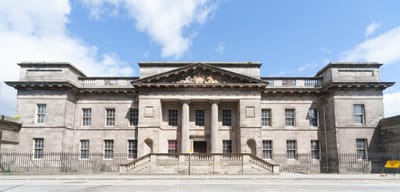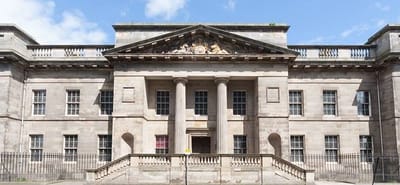Leith Civic Trust
HELP TO KEEP LEITH SPECIAL
Join the Trust
- Leith, Scotland, United Kingdom
RECENT DEVELOPMENTS

This is approaching the start of a very exciting new stage in our story. We are about to make some dramatic changes.
For many years, we and several other Leith organisations have been working to establish a Museum for Leith, and this is now very much on the Horizon.
A few years ago, these organisations managed to persuade the City of Edinburgh Council to purchase Leith Custom House for the purpose with Scottish Historic Buildings Trust (SHBT) as the long-term tenants to run the building and project. This wonderful building will very soon become our new home, whilst work and fundraising continue. Leith Civic Trust will become the Community partner, and we shall run the museum once restoration is complete.
It will be a completely digital operation with video walls, screens and projectors throughout8 dedicated exhibition spaces telling the many stories of Leith and Leithers past and present.
A wonderful new design has been created by Richard Murphy Architects, and this has been accepted by both Edinburgh Council and SHBT.The preparation stage will involve considerable hard work for our members and others. In the first place, we shall need to change charity structure to a SCIO and create all new systems. We shall also need to record the stories which will be told and to find and photograph all the artifacts . Our History group will be working hard for a few years. Leith’s story goes back as far as the stone age, so this will be a long term project..
Steam Turbine Ship Lorena

The 'Lorena' was built in Leith in 1902 for a Mr A. L. Barber from New York (known as the Ashfelt King). She was named after his Daughter, was 300ft long and weighed 1,650 tons. The 'Lorena' undertook her steam trials in August 1903 down the East coast and as her Captain came from Brightlingsea, it was arranged for her to stop in Brightlingsea for coal, before continuing down to Southampton and then to New York. On Monday 10th August 1903 on arrival in Brightlingsea, nine stokers requested shore leave and were told to return by 21.30. At the due time a local Ferryman agreed to take the crewmen back to their vessel, a small and unseaworthy boat was taken from the hard and when within 400yds of the 'Lorena' the overladen vessel foundered. Apart from the Ferryman and a stoker called Jamieson, all the rest were lost. Of all the nine men lost, eight were from Leith. They are buried in an unmarked mass grave in All Saints churchyard in Brightlingsea. Mr Barber paid for the funeral and the cost of bringing Families down to Brightlingsea for the service. The It was undertaken by the Rev: Arthur Pertwee. It was not until 2013 that a commemorative service was held for these victims, and another was held in 2023. The 'Tiles' project have undertaken to install a fitting memorial at the grave site, and the names of those lost will appear in a new tile within the church. They would like to use a sandstone plinth from Leith for the memorial, depicting the Leith coat of arms and a brief outline of the 'Lorena' disaster. We would like to contact the descendants of those Leith victims, who were John Currie, James Douglas, Alexander Smith, John Johnson, John McGregor Andrew Wilson, D. Wilson and F. McLaren. If anyone has any information please get in touch via the attached form.
Present Projects
Leith Civic Trust, together with several other Leith Community organisations, negotiated with the City of Edinburgh Council to save the building for the community. They purchased the building and leased it to SHBT to manage its regeneration and restoration. Since then it has become a thriving hub for creative arts. The longer-term vision is to include a museum, a tourism hub, and more public areas. We have now agreed to become the Leith Community Partner for this project and shall operate the museum after the refurbishment is completed.
String of Pearls
We are now working with other Leith groups and Scottish Historic Buildings Trust to develop walks around Leith’s String of Pearls. It is hoped that these would be well signposted and open to the public where possible. It is hoped that the routes will be shown on a Leith app as well as in tourist paper maps replacing those which we have produced for the last few years.
SS Explorer
SS Explorer is one of the last surviving sea-going steam trawlers and is registered to Leith. She has been placed on the National Historic Ships Register and the SS Explorer Preservation Society is currently restoring her in the Edinburgh Dock, Leith. The Society have a vision for the ship to become a permanent member of the String of Pearls as a museum ship. We fully support this.

100 Days of Leith

The amalgamation was highly contentious and opposed by Leith Town Council who ran a lightning 'plebiscite' (a public referendum) with the Leith Observer newspaper returning a clear 'No' vote to the proposal. The people's vote was not however enough to prevent the Act coming into force and Leith was duly amalgamated, generating strong feelings of resentment amongst Leithers which are detectable to this day!
The Boundaries Extension and Tramways Act 1920 was passed in August 1920 and the first meeting of all eight areas amalgamated into the enlarged Edinburgh Town Council took place on 5th November 1920. In 100 Days of Leith we will be counting down to the fateful centenary by publishing the people's choices about what makes Leith special.
Contact us
Background to the Trust
The Rotary Club of Leith objected to the development, but finally relented when Edinburgh Council agreed to include a Community and Sports Centre. Afterwards Rotary realised that their Constitution did not permit them to undertake such semi-political ventures, and after some public meetings, Leith Civic Trust was established with a Rotarian, Alastair Donald elected as the first chairman.
The Leith Project in 1981–6 started a revival in fortunes. Margaret Street MBE, our hard-working secretary and later Chairman managed to save The King's Wark and Pilrig House. As the active members of the trust grew older the trust gradually became dormant in the early 1990’s.
In 1995 the Cutty Sark Tall Ships Race was started in Leith and many Leith organisations combined to support it. The event was a great success. Despite poor weather, huge numbers of visitors came to Leith and all had a wonderful time. After the race the local police superintendent, Alan Naylor, suggested that this co-operation must be continued and that an organisation must be formed to act as the catalyst. Stewart Valentine, a member of the original committee, led the revival of Leith Civic Trust to be that organisation.
Amongst the early projects were:
Open Spaces Review – This had twin aims – to calculate the numbers and extent of open spaces in Leith, and to maximise their uses for recreation. We intend to return to this project taking into consideration the building developments since that time.
String of Pearls – This was to encourage tourism to Leith. It was wholly accepted by the City of Edinburgh Council. The hub of the project was to be Lamb’s House. Leith Civic Trust created a Friends of Lamb’s House organisation with the enthusiastic support of the owners, The National Trust for Scotland. Unfortunately, there was a change in the situation at the National Trust and they were forced to pull out from the project and sell the building. The new owners have shown just how the building should have been treated. It has been wonderfully transformed. The String of Pearls principle is still valid and we continue to pursue the aims with Leith Custom House as the hub.
Clean Up Leith – We undertook several clean-up operations around Leith. We are delighted that this is now being continued by the Friends of the Water of Leith Basin and others. The road renewal programme is helping in many places, but the Water of Leith is still a complete disgrace, It is extremely silted and there are great concerns that, with the flood prevention measures upstream having removed flood plains, there is a considerably increased danger of flooding in the Shore area.
Wall Plaques – We also discussed the plaques originally placed on buildings by the Leith Development Trust. We are keen to continue the practice and made a list of potential sites. However, insurance costs are prohibitive for any organisation apart from the local authority, and we were unable to persuade the City of Edinburgh Council to undertake the actual erection of the plaques. We are working on a new integrated tourism project which will see more plaques erected.